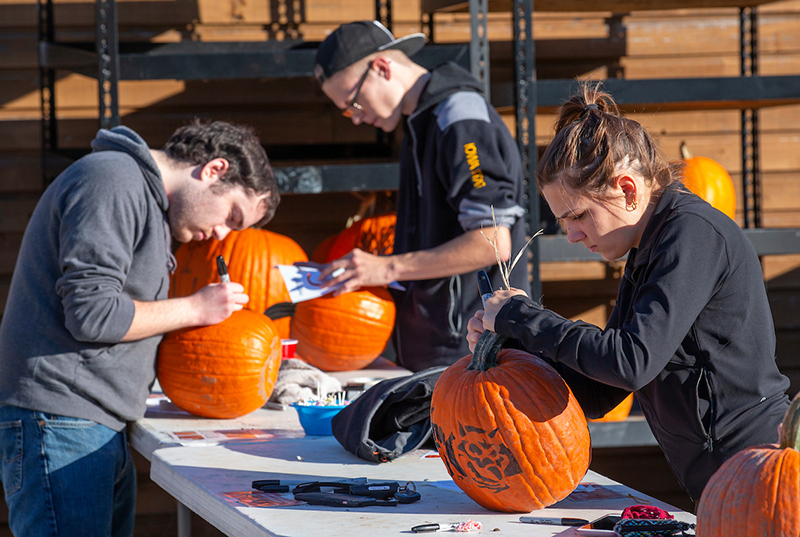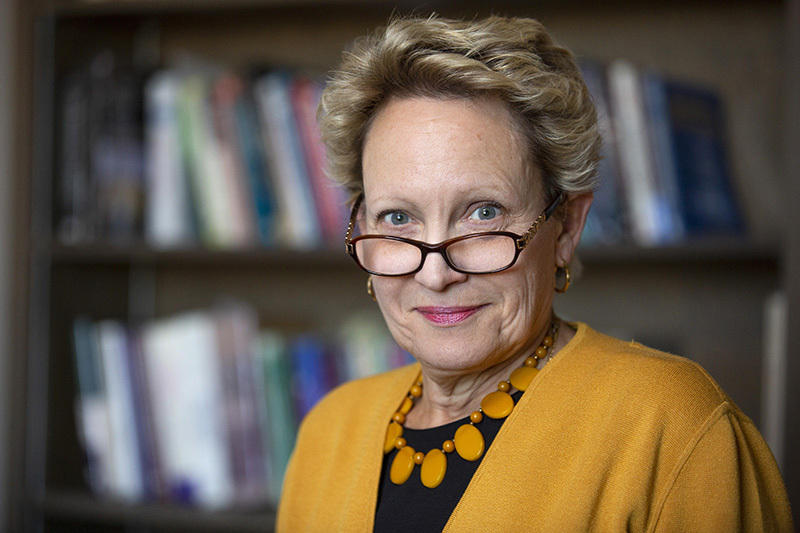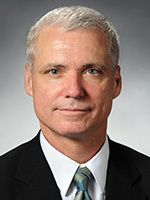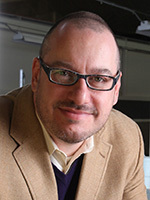All hands on deck

Photo by Christopher Gannon.
Pictured, from left, Iowa State students Daniel Pugliese, junior in chemistry; Keegan Holdorf, sophomore in architecture; and Emily Draper, a pre-business freshman, are among the legion of volunteers stenciling and carving pumpkins -- lots of them -- all week at Reiman Gardens for the annual Spirits in the Gardens Saturday and Sunday, Oct. 20-21 (4-9 p.m.). Early-evening activities will include trick-or-treating, storytelling and meet-a-scientist. If the volunteers meet their challenge, an estimated 600+ jack-o'-lanterns posted across the gardens will light up at dusk.
Town hall planned to address service delivery concerns
Staff and supervisors with questions and concerns about the proposed models for improved service delivery in finance and human resources are encouraged to attend an Oct. 25 town hall (9:30-11 a.m., Howe Hall auditorium). Interim senior vice president for finance Pam Cain and interim vice president for university human resources Kristi Darr will lead the discussion moderated by a representative of the Professional and Scientific Council.
The proposed models, introduced at the beginning of October, change reporting lines and job responsibilities for staff involved in finance and human resources. Hundreds of comments and questions have been submitted online and in person at more than 15 public and group presentations over the last couple of weeks.
The FAQ for improved service delivery continues to grow in response to submitted questions. For example:
- If I currently have HR and finance duties, will they be separated?
- How will units be defined?
- Where will functional specialists be physically located?
- Will merit staff be impacted by the new models?
- What is the timeline for transition to the new models?
More details
Cain and Darr plan to talk in more detail about their visions for the proposed models and the need for improved service delivery, including its close relationship to Workday changes in HR and finance. The way ISU does its finance and human resources work will change when the Workday software system goes live July 1, 2019.
The Oct. 25 town hall meeting will be livestreamed. Recordings of the initial presentations and P&S Council open forum are available online. Questions and feedback can be submitted anonymously on the WorkCyte website (extended through Oct. 26) and by email to the P&S Council (through Oct. 25).
The Institutional Effectiveness Leadership Team that collaborated with campus leaders to develop the proposed models will submit its final recommendation to President Wendy Wintersteen in November. Employees will receive periodical email updates on the initiative (sent from "Improved Service Delivery Campus Outreach"), including one today with information about the Oct. 25 town hall.
Five questions with the English 150/250 course director

Barbara Blakely is an associate professor of English who has overseen the ISUComm foundation courses, English 150 and 250, since 2007. Photo by Christopher Gannon.
- Name: Barbara Blakely
- Position: Director of ISUComm foundation courses, associate professor of English
- Years at ISU: 35
- Students per calendar year in 150/250: 6,500-7,200
- Sections per calendar year in 150/250: Up to 300
Few Iowa State faculty have an impact on more students than Barbara Blakely, an associate professor of English who since 2007 has been the course director for English 150 and 250 -- the "foundation" communications courses required for all undergraduate students. Each year, thousands of students take the courses, which cover written, oral, visual and electronic communication and lay the groundwork for success in further studies, careers and life.
What does a course director do?
I oversee everything that has to do with the two courses in the ISUComm foundation program. I create template syllabi, not that instructors can't modify that. I prepare new teaching assistants. We mentor them all through the year. I do some annual reviews of lecturers. I do test-out exams for 150 and 250. I look at admissions folders for graduate students who want to be teaching assistants. There are a lot of things. The main part of it is the creation of the course materials.
How similar is overseeing a vast multisection course like this to being in a classroom?
It is different in that I need to have a bird's-eye view on the whole thing. But without being in the classroom and listening to instructors' experiences, I wouldn't be able to make decisions to guide the program. We go out and visit a lot of classrooms. Often times, the instructor thinks I'm there to watch them. That may be a tiny piece of it. But I'm also just looking to see how is this working, how are the students responding. It's never a matter that everyone is doing the same thing, lock-step. On the other hand, we can't just throw it open and say, 'Well, you just teach it however it makes sense to you.' I feel like I'm making a promise to students that, 'This is what the university wants you to get.' We need to deliver on that while not forcing instructors and students into a follow-the-bouncing-ball type of curriculum.
What are the key improvements you've made to the courses?
One of them is the campus place-based curriculum. That has been a really popular way to help students -- many who are coming to a large university from smaller towns or from abroad -- make that transition and find their place, to link to the larger trajectory, history and mission of Iowa State University and its land-grant status. When they start looking at some of the programs and organizations that represent that -- Reiman Gardens, the Iowa Water Center, the Beginning Farmer Center -- then they get it. They develop a sense of place.
The other thing I spearheaded is the creation of electronic portfolios. Students who create e-portoflios and use them along the way are more engaged in their learning. The reflective part of that is a meta-cognitive piece: 'What am I doing, why do I do it that way, how do I learn best, how does this connect to something that's coming up or maybe something I did in high school?' It's not just finishing it, stapling the paper, handing it in and saying, 'I'm done.' It's taking that extra step and cementing it.
Are there any online-only course sections?
In 150 and 250, so far, it's only face-to-face. I don't know whether that's going to change or not. I have misgivings about it, though I'm sympathetic to the idea that we want to serve as many students as we can and be as accessible as we can be. Particularly the 150 class, though -- many of those students are new, many are first-generation, and they need that connection with other students and with the instructor. I'm not saying that couldn't happen online, but it would have to be done really, really well. We hear over and over again from students in 150 and 250 that we are the smallest class that they have and we are the only instructors who know their names. That really means something to the students. I hate giving that up.
What sort of impact do you think social media and smartphones have had on reading and writing skills?
There's always something society is pointing at that's going to be the downfall of the next generation. I started teaching this class in 1983 when we didn't have those things. I don't see that there's a difference in students today. I don't see that they have more trouble or less trouble. I think they're more communicative. They're used to tapping in and finding answers or connecting with people, and I don't think that's a bad thing. It certainly gives us a way to capitalize on that digital component in society. Yes, that's the way the world is now -- school, work, personal lives. So, let's talk about how rhetorical principles apply to the digital world -- audience, material, organization, style and delivery. Sometimes your delivery is going to be a text message.
Two finalists named in Student Innovation Center director search

James Oliver
Faculty members James Oliver and David Ringholz are finalists in the internal search for the inaugural director of the Student Innovation Center.
The center, presently under construction on the west side of campus, should be completed in spring 2020. The director will provide overall leadership, vision and direction for the facility -- including planning and implementing academic programming -- and foster engagement with students and external stakeholders. It is a full-time position.
The finalists will meet with the search committee, academic deans and the Student Innovation Center steering committee, and hold an open forum for interested students, faculty and staff. The forum schedule is:
- Ringholz, Monday, Oct. 29, noon-1 p.m., Howe Hall auditorium
- Oliver, Friday, Nov. 2, 2-3 p.m., College of Design auditorium

David Ringholz
Oliver, University Professor and Larry and Pam Pithan Professor of Mechanical Engineering, joined the Iowa State faculty in 1991. He has directed the Virtual Reality Applications Center since 2004, the university's graduate program in human computer interaction since 2003 and is co-founder of BodyViz, a technology startup focused on medical visualization.
Ringholz, associate professor and chair of industrial design, joined the Iowa State faculty in 2010 to establish the program in the College of Design. He has grown the department significantly, including developing a robust industry engagement program. He also served as principal investigator on the Provost’s Strategic Initiative on Interdisciplinary Design Education and Research (2011-14).
Information about the search, including an online feedback form, is on the provost's office website.
Related story
- Faculty applicants sought for new facility director, July 19, 2018
Five departments capture 30 percent of ISU graduate students
Nearly 30 percent of Iowa State graduate students this semester are studying in one of five departments. Three of the top five departments are in the College of Engineering, with the agronomy department and School of Education also in the group.
The numbers include students pursuing a graduate certificate, but don't double-count students doing both. Certificate-only students impact the top 10 ranking in just one instance: The food science and human nutrition department, which enrolls the third-highest number of female graduate students, counts about 70 certificate-only students among 116 female students.
Not included on this list are 597 students in the College of Veterinary Medicine working toward a DVM (Doctor of Veterinary Medicine), recognized as Iowa State's lone professional program. Four out of five DVM students at Iowa State this fall are female.
The office of the registrar compiles and posts enrollment data every semester.
Male, female interest
Iowa State enrolled 2,728 male graduate students this fall (57 percent of all graduate students) and 2,046 women (43 percent), identical to the gender split in this fall's undergraduate student body.
The top 10 enrolling departments for male graduate students nearly mirrors the list for all graduate students. A high number of female students earning education degrees puts that school on the overall list, the only unit that ranks in the top 10 overall but not in the male list. Instead, aerospace engineering made the male students list (No. 8).
Six departments made all three top 10 lists for graduate enrollment, including agronomy; business administration; chemistry; civil, construction and environmental engineering; electrical and computer engineering; and statistics.
Fall 2018: Departments with highest graduate enrollments
|
No. |
All graduate students |
Male students |
Female students |
|
1 |
Electrical and computer engineering (404) |
Electrical and computer engineering (333) |
Education (164) |
|
2 |
Agronomy (279) |
Mechanical engineering (203) |
Food science and human nutrition* (116) |
|
3 |
Mechanical engineering (257) |
Agronomy (184) |
Agronomy (95) |
|
4 |
Education (234) |
Civil, construction and environmental engineering (142) |
English (78) |
|
5 |
Civil, construction and environmental engineering (199) |
Computer science (135) |
Apparel, education studies and hospitality management (71) |
|
6 |
Computer science (185) |
Business administration (105) |
Electrical and computer engineering (71) |
|
7 |
Business administration (161) |
Industrial and manufacturing systems engineering (105) |
Chemistry (58) |
|
8 |
Industrial and manufacturing systems engineering (151) |
Aerospace engineering (91) |
Statistics (58) |
|
9 |
Chemistry (148) |
Chemistry (90) |
Civil, construction and environmental engineering (57) |
|
10 |
Statistics (137) |
Statistics (79) |
Business administration (56) |
*Includes about 70 certificate-only dietetics students
Related story:
- Twenty percent of undergrads are in one of five majors, Oct. 11, 2018
Homecoming is a Saturday-to-Saturday celebration
Iowa State's Homecoming has evolved into a Saturday-to-Saturday celebration, beginning Oct. 20 with Yell Like Hell preliminary performances and pizza lunch on central campus and painting Victory Lane north of the football stadium, and continuing through the football game seven days later. "This is State" is the theme for Homecoming 2018, organized by the alumni association.
A full schedule of events is online. Events are free unless noted. Here are a few highlights:
Downtown parade
The third annual Homecoming parade departs from the south side of City Hall downtown at 2 p.m. Sunday, Oct. 21. The parade will head east on Fifth Street to Douglas Avenue, south one block and then west on Main Street to the Grand Avenue overpass.
Parade entrants include the Homecoming Cardinal Court, student and administrative leaders, student organizations and local businesses and organizations.
Homecoming buttons, $5 each, may be purchased at the ISU Book Store, Alumni Center and online. Button sale proceeds support Homecoming programs.
In addition to showing Cyclone spirit, a button provides you free lunch on central campus every day next week. Organizers are adding a faculty-staff line this year to shorten the time employees spend in line.
Here's who is providing lunch each day, Oct. 22-26 (10:30 a.m.-1 p.m. unless noted):
- Monday, Erbert and Gerbert's
- Tuesday, Chick-fil-A
- Wednesday, Fuzzy's Tacos
- Thursday, 7:30-10 a.m. (breakfast), Panera Bread
- Friday, 11 a.m.-2 p.m., Iowa Beef Council
Your button also gives you free admission to the Cyclones-Texas Longhorns volleyball match on Wednesday, Oct. 24 (8 p.m., Hilton Coliseum).
Awards ceremony
The alumni association's 87th annual honors and awards ceremony, which also includes college-specific awards, will begin at 1:15 p.m. Friday, Oct. 26, in Benton Auditorium, Scheman. A reception follows. The ceremony will be livestreamed on the alumni association's website.
Friday evening at the Alumni Center
Multiple events roll into each other Friday afternoon and evening at the Alumni Center. A happy hour runs from 4 to 6 p.m. The CYlent auction, which supports student scholarships, runs from 4 to 8 p.m. Friday and again during the Saturday morning Cyclone Central tailgate (8-10:30 a.m.). Online bidding has opened and continues through 12 a.m. Oct. 28. The Homecoming pep rally runs from 6 to 9 p.m. and includes ISU coaches and student athletes and final performances of the student "Yell Like Hell" spirit competition. Homecoming button holders can enjoy two slices of pizza and a bottle of soda or water during the pep rally.
Excytement in the Streets, a self-tour of lawn displays, parade floats and even a few skits in the Greek neighborhood west of the Alumni Center, runs from 8 to 10 p.m. Friday.
Rounding out the evening are a pancake feed ($3, 11 p.m.-1 a.m., central campus) and mass campaniling under a fireworks show at midnight.
The Homecoming football game with Big 12 Conference opponent Texas Tech kicks off at 11 a.m. Saturday, Oct. 27, at Jack Trice Stadium. Tickets ($35-$50) may be purchased online via Ticketmaster.
Student competitions
These performances are free and open to the public.
-- CyFactor talent competition, Wednesday, Oct. 24 (7:15 p.m., Alumni Center), features qualifying performances from Oct. 9-10 auditions
-- Yell Like Hell spirit competition, each skit integrates the "This is State" Homecoming theme and ISU fight song, reserved seating is an option at each performance, student teams paint up after first cuts
- First cuts: Saturday, Oct. 20 (1-5 p.m., central campus)
- Second cuts: Wednesday, Oct. 24 (6-9 p.m., central campus)
- Finals: Friday, Oct. 26, part of the pep rally (6-9 p.m., Alumni Center)
